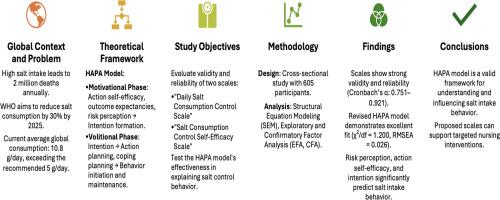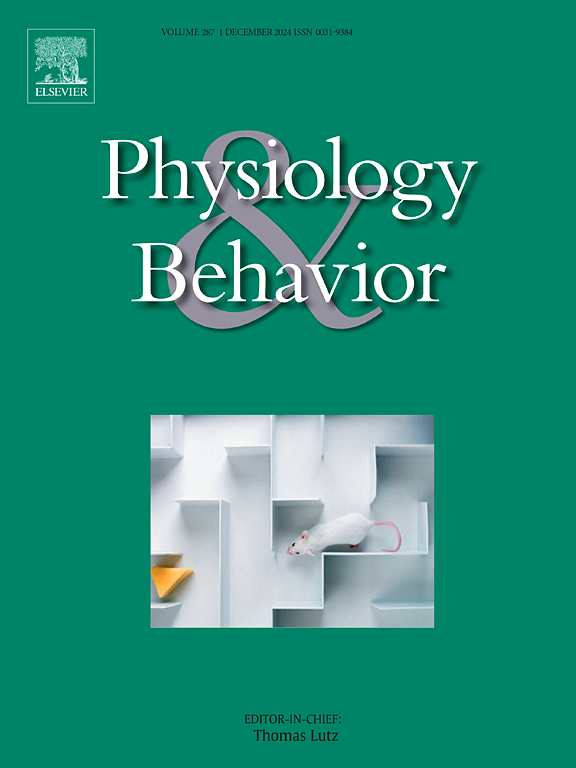Determining factors affecting daily salt intake in adults based on the health action process approach model
IF 2.5
3区 医学
Q2 BEHAVIORAL SCIENCES
引用次数: 0
Abstract
High salt consumption is one of the causes of cardiovascular disease, which is the leading cause of death, and daily salt consumption in the world is above the World Health Organization's recommendation. The aim of this study is to evaluate the validity and reliability of the 'Daily Salt Consumption Control Scale' and the 'Salt Consumption Control Self-Efficacy Scale,' and to determine the factors affecting daily salt consumption based on the Health Action Process Approach (HAPA) model using structural equation modeling. This study is a cross-sectional, methodological and correlational study. Data were collected from 300 adults for the validity and reliability analyses, during January 2023 and 305 adults for HAPA model testing at two separate times between March and April 2023. Descriptive statistics, validity and reliability analyses, and Structural Equation Modeling were used to analyze the data. Both scales demonstrated satisfactory model fit indices in confirmatory factor analyses. Risk perception, action and coping planning, and coping self-efficacy, had a direct effect on action control related to daily salt consumption, while negative and positive outcome expectancies, action self-efficacy, intention, and recovery self-efficacy had an indirect effect. The total variance in action control explained by the variables was 36.4 %. Both scales are valid and reliable measurement tools. The HAPA model effectively explains action control related to daily salt consumption. Clinicians may consider enhancing self-efficacy, outcome expectancies, and risk perception to support efforts aimed at reducing salt consumption. These findings suggest that the HAPA model and the validated scales can be effectively used to guide behavioral interventions aimed at reducing daily salt consumption.

基于健康行动过程方法模型的成人每日盐摄入量影响因素的确定
高盐摄入是导致心血管疾病的原因之一,而心血管疾病是导致死亡的主要原因,而世界上的每日盐摄入量超过了世界卫生组织的建议。本研究的目的是评估“日盐消费控制量表”和“盐消费控制自我效能量表”的效度和信度,并基于健康行动过程方法(HAPA)模型,采用结构方程模型确定日盐消费的影响因素。本研究是一项横断面、方法学和相关性研究。在2023年1月对300名成人进行了效度和信度分析,并在2023年3月至4月的两个不同时间对305名成人进行了HAPA模型测试。采用描述性统计、效度、信度分析和结构方程模型对数据进行分析。在验证性因子分析中,两个量表的模型拟合指标都令人满意。风险感知、行动和应对计划、应对自我效能感对每日盐摄入量相关的行动控制有直接影响,而消极和积极的结果预期、行动自我效能感、意愿和恢复自我效能感对每日盐摄入量相关的行动控制有间接影响。由变量解释的动作控制总方差为36.4%。两种量表都是有效可靠的测量工具。HAPA模型有效地解释了与每日盐摄入量相关的行为控制。临床医生可以考虑提高自我效能、结果预期和风险认知,以支持旨在减少盐摄入量的努力。这些发现表明,HAPA模型和经过验证的量表可以有效地用于指导旨在减少每日盐摄入量的行为干预。
本文章由计算机程序翻译,如有差异,请以英文原文为准。
求助全文
约1分钟内获得全文
求助全文
来源期刊

Physiology & Behavior
医学-行为科学
CiteScore
5.70
自引率
3.40%
发文量
274
审稿时长
47 days
期刊介绍:
Physiology & Behavior is aimed at the causal physiological mechanisms of behavior and its modulation by environmental factors. The journal invites original reports in the broad area of behavioral and cognitive neuroscience, in which at least one variable is physiological and the primary emphasis and theoretical context are behavioral. The range of subjects includes behavioral neuroendocrinology, psychoneuroimmunology, learning and memory, ingestion, social behavior, and studies related to the mechanisms of psychopathology. Contemporary reviews and theoretical articles are welcomed and the Editors invite such proposals from interested authors.
 求助内容:
求助内容: 应助结果提醒方式:
应助结果提醒方式:


